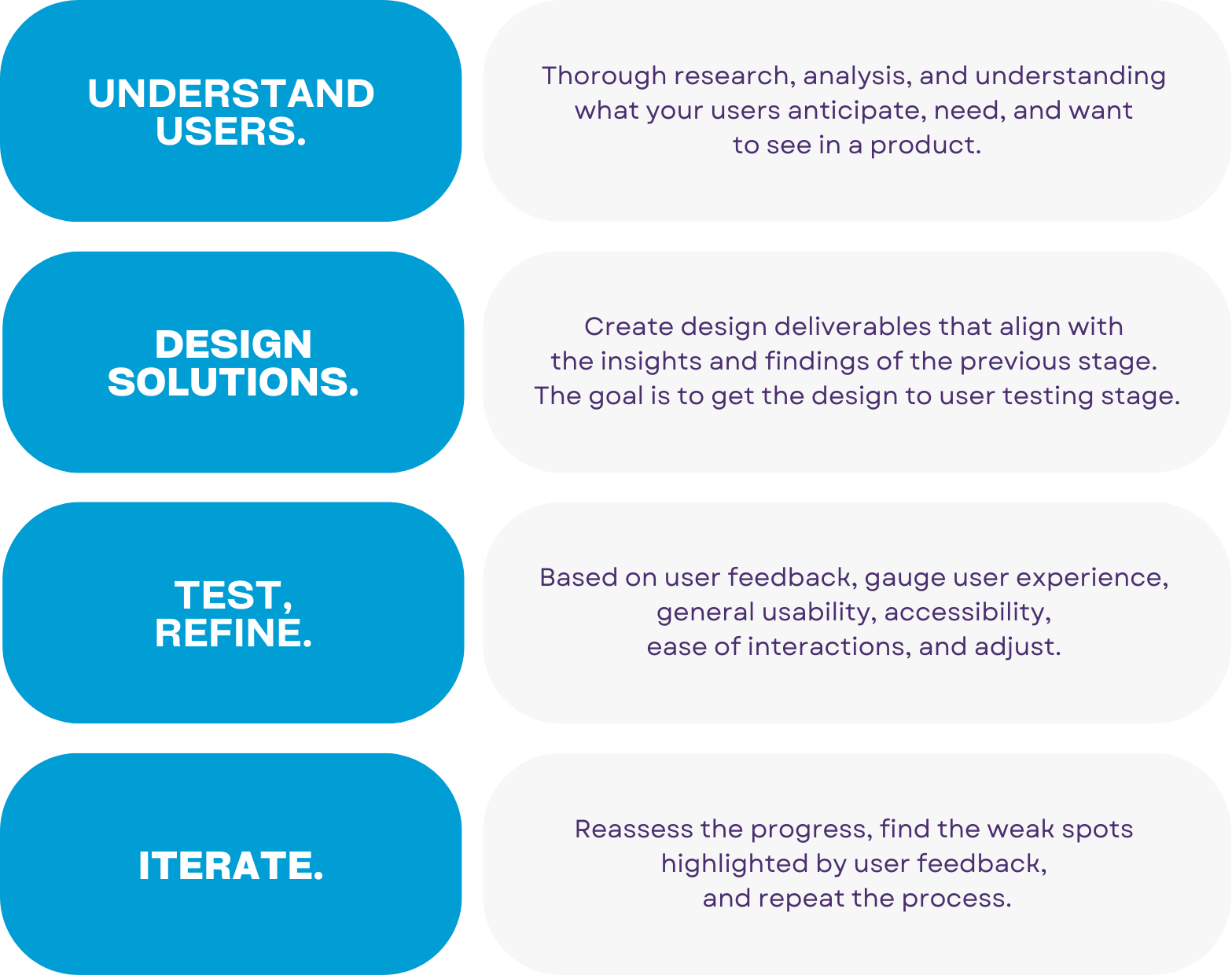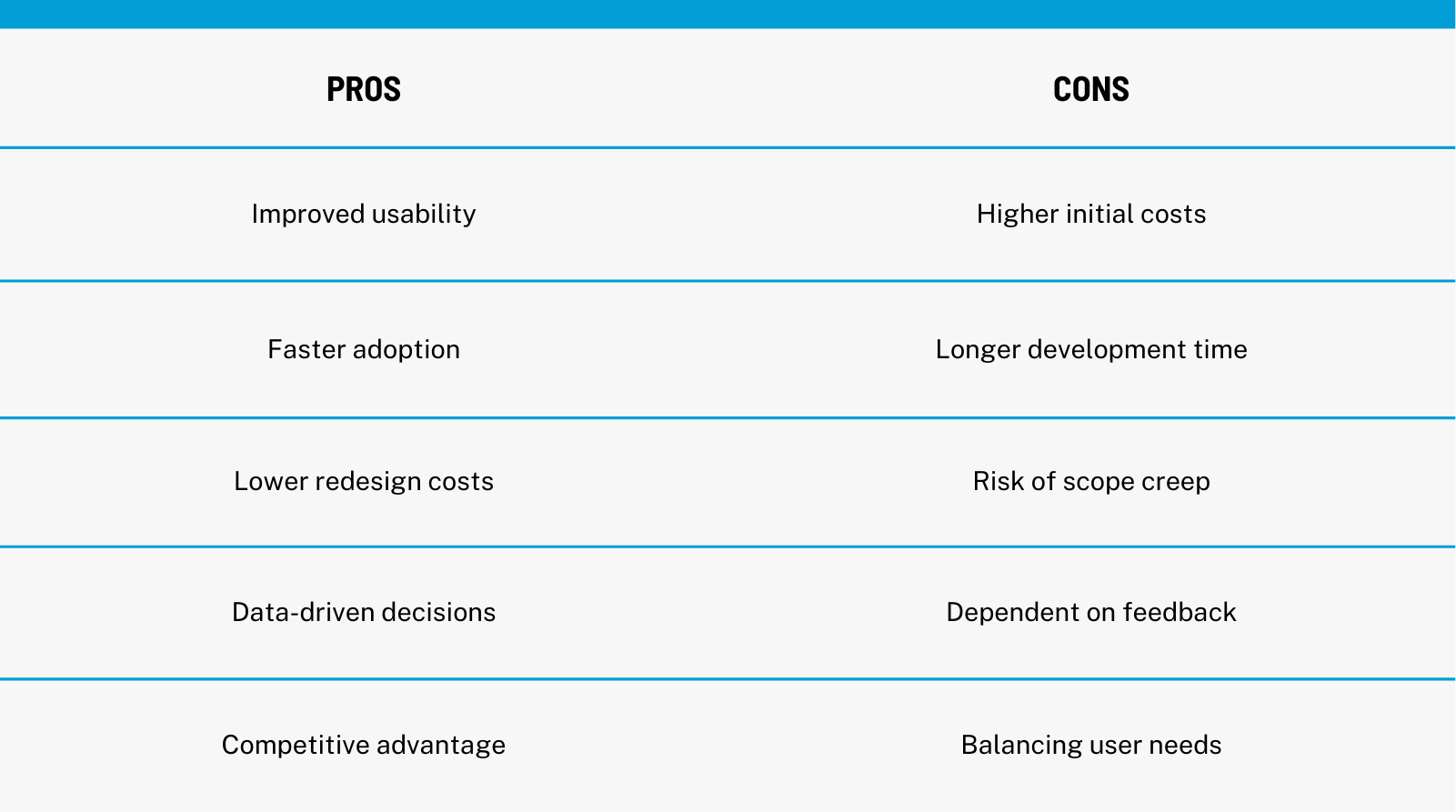Today users expect software that is intuitive, efficient, and tailored to their needs. Frustrating users with poor usability, confusing navigation, or features they don’t actually need is one of the biggest blows that you can deal to any chance of success for your software. This is where User-Centered Design (UCD) comes into play.
User-Centered Design (UCD) is a user-driven product design methodology that prioritizes end users throughout the entire software development lifecycle. Instead of making assumptions about what users want, the UCD process involves continuous feedback, iterative testing, and real-world validation to ensure that the final product is both functional and enjoyable to use.
In this article, we’ll explore:
- What is User-Centered Design and how it differs from traditional development approaches.
- Why a user-focused design process leads to better software adoption and long-term success.
- The key benefits, challenges, and best practices of implementing UCD in digital product development.
What is User-Centered Design (UCD)?
User-Centered Design (UCD) is a user-oriented design approach that ensures digital products are built with real users in mind at every stage of development. Unlike traditional development models, where features and interfaces are often dictated by business requirements alone, UCD integrates user feedback early and continuously, shaping the product around actual needs rather than assumptions.
At its core, the user-centered design process follows an iterative cycle that includes:
- Understanding Users: Conducting research, project discovery, user interviews, and behavioral analysis to define who the users are and what challenges they face.
- Designing User-Centered Solutions: Creating software prototypes, wireframes, and user flows that align with the real-world needs and behaviors of the target audience.
- Testing & Refining: Gathering user feedback through usability testing, refining interactions, and adjusting based on how users actually engage with the product.
- Iterating Based on Insights: Continuous improvement to enhance the usability, accessibility, and efficiency of the software.
Unlike static, one-time design processes, UCD thrives on flexibility, making it a user-driven design method that evolves alongside user needs. This ensures that products are not just functional but truly intuitive, offering seamless, personalized experiences that drive higher engagement, adoption, and satisfaction.

Why Adopt UCD in Software Development?
User satisfaction can make or break a product. A software solution that frustrates users with poor usability, unnecessary complexity, or difficult navigation will quickly lose engagement, no matter how powerful its features might be. This is why adopting a user-centered design process ensures that every design decision is driven by real user needs, resulting in more intuitive, efficient, and valuable software.
The Key Benefits Of Implementing User-Centered Design:
Boosts Usability & Adoption
- A user-based design approach ensures that digital products are easy to use from the start, reducing the learning curve and increasing engagement.
- Users feel more confident and satisfied when software is intuitive, which leads to higher adoption rates.
Reduces Costly Revisions & Development Waste
- By incorporating user feedback early and continuously, teams avoid expensive redesigns late in the development process and wasted development resources.
- Fixing usability issues after launch is far more costly than addressing them during development.
Enhances Product-Market Fit
- A user-oriented design ensures that the final product aligns with real-world user needs rather than internal assumptions.
- This results in better retention, loyalty, and long-term success.
Improves Decision-Making Through Data
- UCD relies on real user feedback, usability testing, and behavioral insights, leading to more informed design decisions.
- Instead of guessing what users want, teams iterate based on actual data, reducing the risk of launching a misaligned product.
Creates a Competitive Advantage
- Companies that embrace user-driven design set themselves apart by offering superior user experiences.
- Products designed with UCD often gain a reputation for reliability and ease of use, which can become a major differentiator in the market.
- A reputation for high usability leads to greater customer satisfaction, loyalty, and word-of-mouth recommendations
By integrating user-centered design into the software development lifecycle, businesses create software that not only meets user needs but also drives long-term success. However, while UCD offers significant advantages, it also presents certain challenges. Let’s explore some key considerations in implementing UCD effectively.
Challenges & Considerations in Implementing User-Centered Design
While user-centered design (UCD) offers significant benefits, it also presents challenges that teams must navigate carefully. A user-driven design process requires time, resources, and a structured approach to ensure that feedback is effectively integrated without derailing software development goals. Here are some common challenges—and strategies to overcome them.
Increased Time & Cost in Development
The UCD process involves continuous user research, iterative testing, and refinement, which can extend development timelines and require additional budget.
- Solution: Teams should plan for UCD from the start, incorporating usability testing and feedback loops into project timelines to prevent last-minute delays.
Scope Creep & Feature Overload
As users engage with prototypes, they may suggest new features or modifications, potentially expanding the project beyond its initial scope.
- Solution: Establish clear priorities and use a structured approach like MSCW prioritization (Must-have, Should-have, Could-have, Won’t-have) to keep the product aligned with business goals while integrating valuable user insights.
Dependence on User Feedback
UCD relies on input from real users, but if the testing group is too small or not representative of the broader audience, the product may end up optimized for a niche subset of users rather than the market as a whole.
- Solution: Ensure a diverse and representative testing group and combine quantitative (analytics, surveys) and qualitative (interviews, usability tests) research methods to capture broader insights.
Risk of Over-Customization
Some teams may tailor solutions too closely to specific user groups, making it difficult to scale the product for different industries or markets.
- Solution: Maintain a balance between customization and general usability—design for flexibility while keeping core functionality adaptable.
Organizational Resistance to Change
Teams accustomed to feature-driven development may resist shifting to a user-focused design approach, seeing it as an added layer of complexity.
- Solution: Advocate for UCD as a cost-saving and efficiency-boosting strategy, demonstrating how it reduces long-term rework and improves product success metrics like engagement, retention, and customer satisfaction.
Turning Challenges into Strengths
While UCD implementation requires effort, the long-term benefits far outweigh the challenges. By integrating user feedback strategically, managing scope carefully, and ensuring broad representation in testing, teams can build products that are both user-friendly and scalable.

Best Practices for Implementing User-Centered Design
User-centered design (UCD) is most effective when applied as an ongoing, structured design process rather than a one-time initiative.
To ensure a product is truly user-driven, teams must integrate user insights throughout the entire development lifecycle. Below are the key practices that help create intuitive, efficient, and engaging digital products.
Start with User Research
Before making any design decisions, it’s crucial to understand the target audience—their needs, behaviors, pain points, and expectations. This is best done through user interviews, surveys, usability testing, and behavioral analysis.
A research-driven approach minimizes guesswork and ensures that product decisions are based on real-world insights rather than assumptions. Without this foundation, teams risk investing time and resources into features that fail to address actual user needs.
Prototype & Test Early
Waiting until the final stages of development to validate a design can lead to costly rework and usability issues. Instead, teams should develop low-fidelity wireframes and interactive prototypes that allow for early user testing.
By gathering feedback on functionality, navigation, and overall user experience early in the process, designers can iterate quickly and refine the product before major development investments are made.
Iterate Based on Feedback
The UCD process is an ongoing cycle of refinement, where each iteration improves usability based on real user interactions. Gathering feedback is essential, but it’s equally important to analyze, prioritize, and implement changes strategically.
Not every user request should be immediately integrated—teams should ensure changes align with both user needs and business objectives.
Balance User Needs with Business Goals
While user feedback is at the core of user-centered design, development teams must also consider factors such as feasibility, scalability, and business strategy. A successful UCD process ensures that design decisions support both usability and company objectives. The goal is to design a product that is user-friendly but also sustainable in terms of growth, performance, and long-term market fit.
Ensure a Representative Testing Group
A common challenge in user-driven design is relying on a limited or non-representative user pool. If feedback comes only from a small subset of users, the product may fail to scale effectively. To mitigate this, teams should involve diverse user groups—including individuals with varying skill levels, accessibility needs, and use cases. This approach ensures that the final product works well for a broad audience rather than a niche subset.
Monitor & Improve Post-Launch
UCD does not stop when the product goes live. Real-world usage provides the most valuable insights into how users interact with the software, highlighting areas for refinement and future improvements. Teams should continuously track analytics, heatmaps, user feedback, and support requests to identify usability bottlenecks and optimize the experience over time. A product that evolves with user needs is far more likely to retain engagement, reduce churn, and drive long-term success.
The Takeaway
User-centered design (UCD) is more than just a methodology—it’s a proven strategy for building digital products that truly meet user needs. By prioritizing research, early testing, iterative improvements, and continuous monitoring, businesses can create intuitive, efficient, and engaging experiences.
A successful user-centered design process balances user expectations with business goals, ensuring that software is both functional and scalable. Teams that embrace user-driven design reduce costly rework, enhance adoption rates, and gain a competitive advantage by delivering products that users actually want to use.
Ultimately, UCD isn’t just about better design—it’s about long-term product success. The more user-focused your approach, the stronger your software’s impact will be.